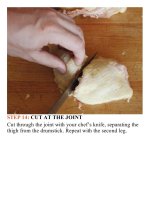The food lab better home cooking through science ( PDFDrive ) 1063
Bạn đang xem bản rút gọn của tài liệu. Xem và tải ngay bản đầy đủ của tài liệu tại đây (177.33 KB, 2 trang )
oven. This expansion brings lightness and crispness to
friedfoods.
• Protein coagulation. Cooking in hot oil precipitates the
rapidcoagulationofproteins.Justasproteinssetinaloaf
of bread or a pancake, giving it more structure and
rigidity,sodotheysetinthebatterorbreadingcoatinga
piece of fried food. It’s this protein matrix—usually
comprised of gluten in a flour-based batter, or egg
proteins in a basic breading—that gives rigid structure to
fried foods, transforming the batter or coating into a firm
solid.
• Browning and caramelization. The Maillard reaction—
thecomplexstringofchemicalreactionsthatgivesflavor
and color to well-browned foods—as well as
caramelization—the similar reaction that occurs when
sugars are heated—take place rapidly at normal frying
temperatures.Thisiswhatgivesfriedfoodstheirenticing
goldenbrowncoloranddeliciousflavor.
• Oil absorption. As water is forced out of food through
evaporation, it leaves spaces behind. What moves in to
take the place of that water?The only thing that can: oil
fromthefryer.It’saninevitablepartoffrying,essentialto
the flavor of the finished food.And, despite what many
booksmaytellyou,fryingathighertemperatureswillnot
reduce the amount of oil your food absorbs (quite the
opposite,infact,seehere).
Seemcomplicated?It’snot.Thebeautifulthingaboutdeepfryingisthatonceyou’vegottherightamountofoilheated
to the right temperature, all of these things happen on their
own,withverylittledirectionneededfromyou,thecook.
THEWOK:THEBESTVESSEL
FORDEEP-FRYING
F
ryinginaDutchovenworksreasonablywell,but
it’s got its problems: its straight sides make
maneuveringfoodinsideitdifficult.Youcouldgoout
and get a dedicated deep fryer, but do you really
have room on your counter for that? * Here’s a
better alternative: I’d be willing to wager that
anyonewhocomplainsabouthowdifficultandmessy
itistodeep-fryathomehasnevertrieddeep-frying
in a wok.Why don’t people fry at home?The most
common answers are: it’s messy, it’s expensive
(“What do I do with all the leftover oil?”), and it’s
unhealthy.Well,awokcanhelpsolveyourfirsttwo
problems; you’re on your own for the third. Frying
adds fat to your food, period—try eating a few
fewerFrenchfriesoronlyonepieceoffriedchicken
ifyoudon’twanttheextracalories.
The flared sides of a wok offer several
advantagesoverastraight-sidedsaucepanorDutch
oven:
•Thereislessmess.Ifyou’veevertrieddeep-frying









